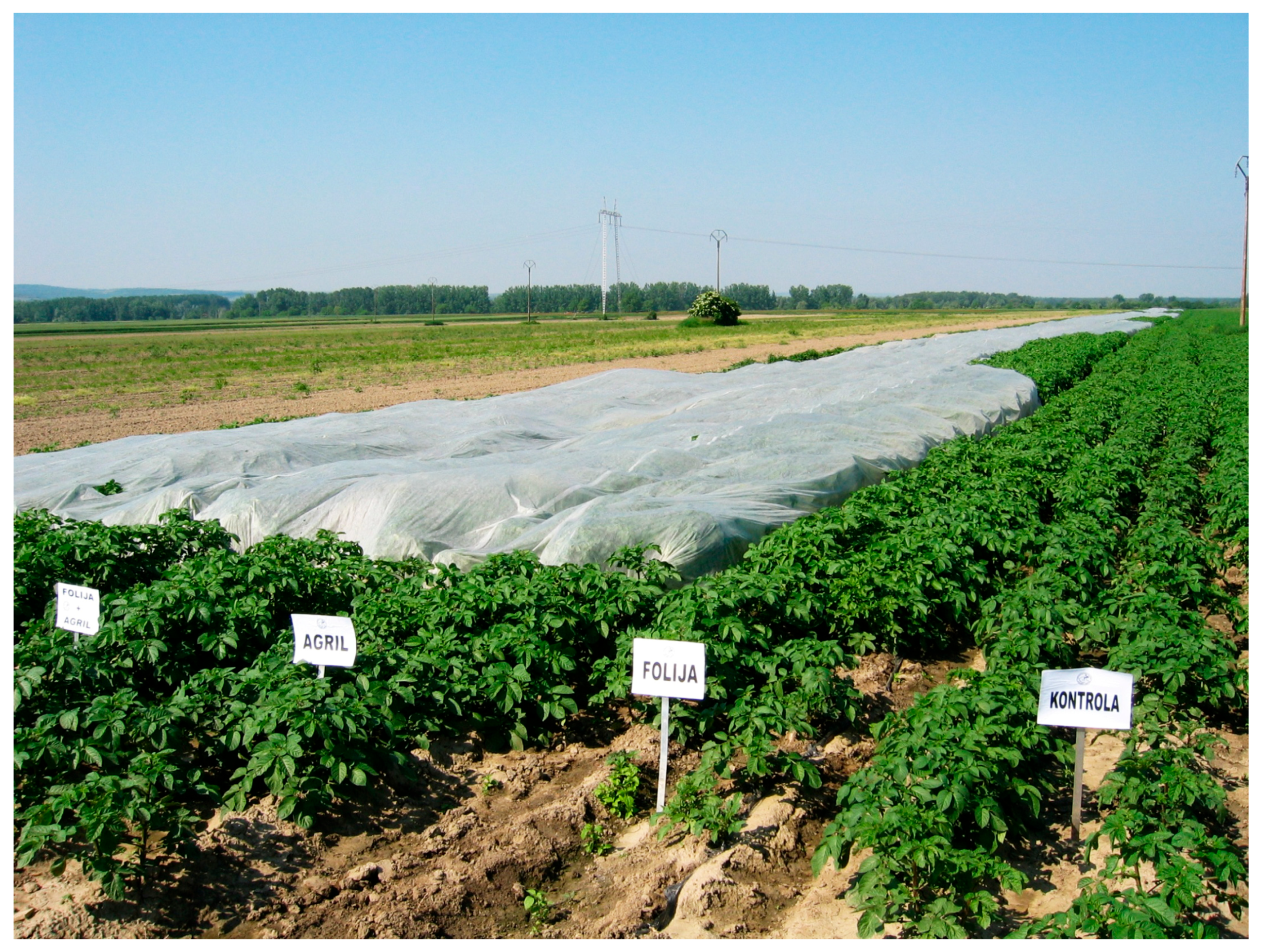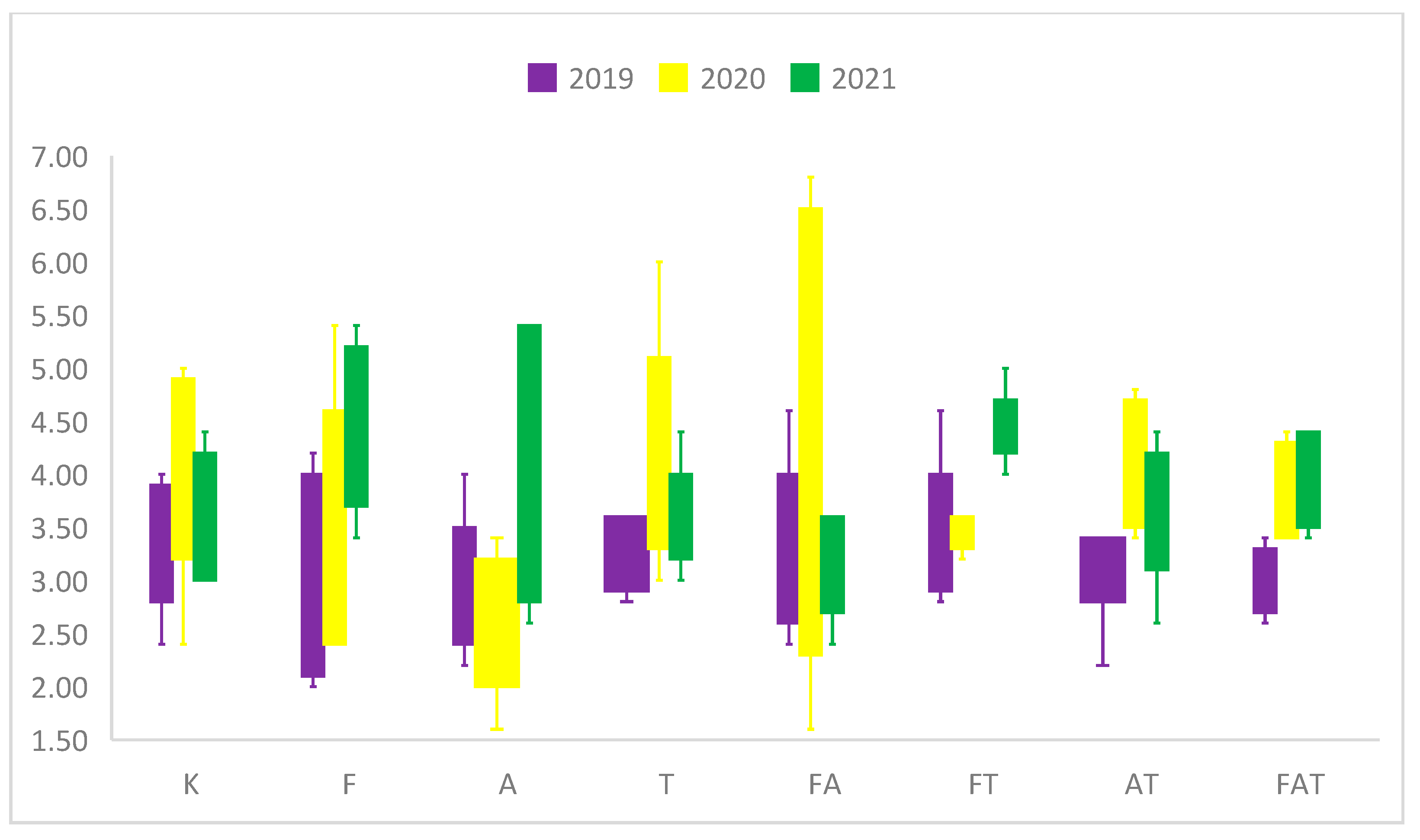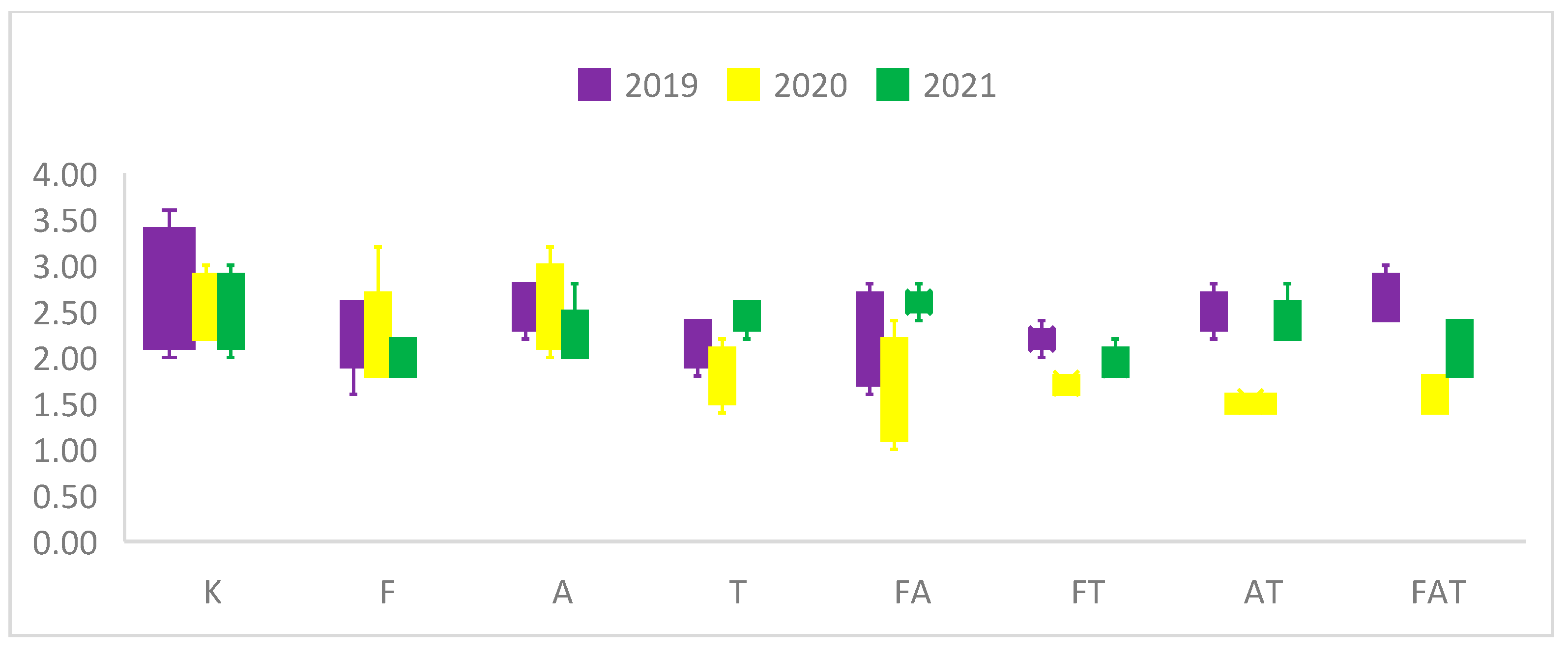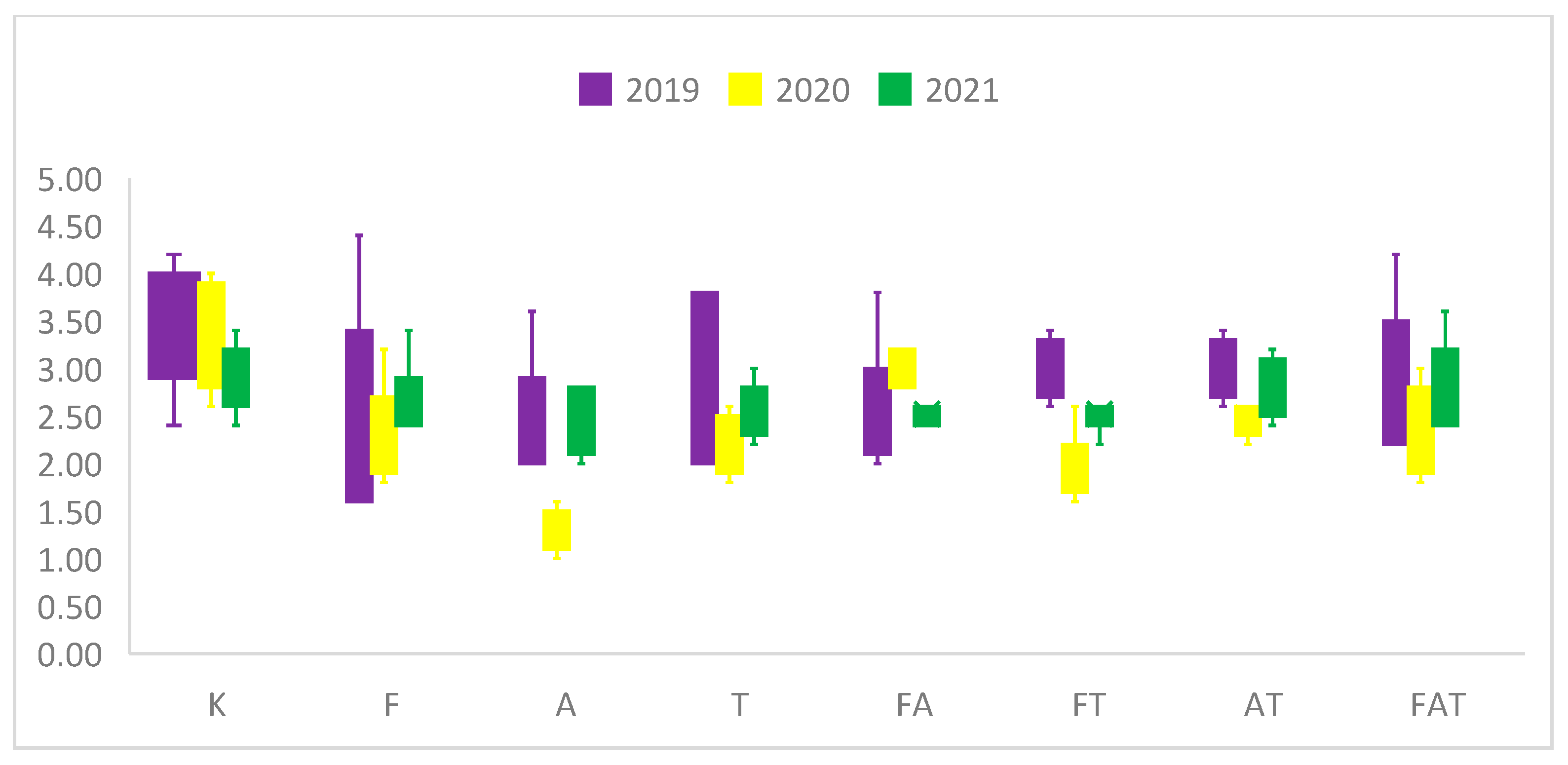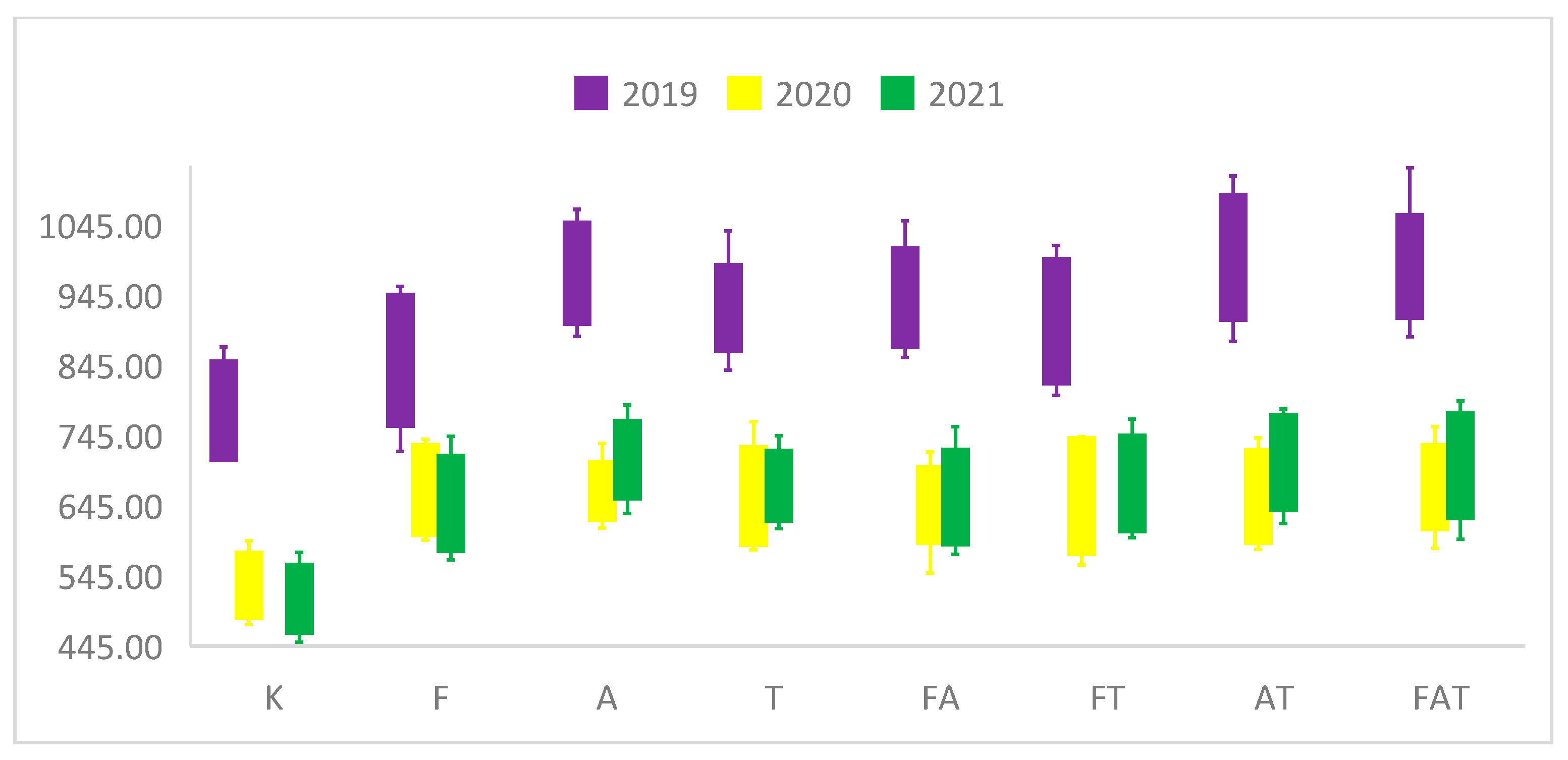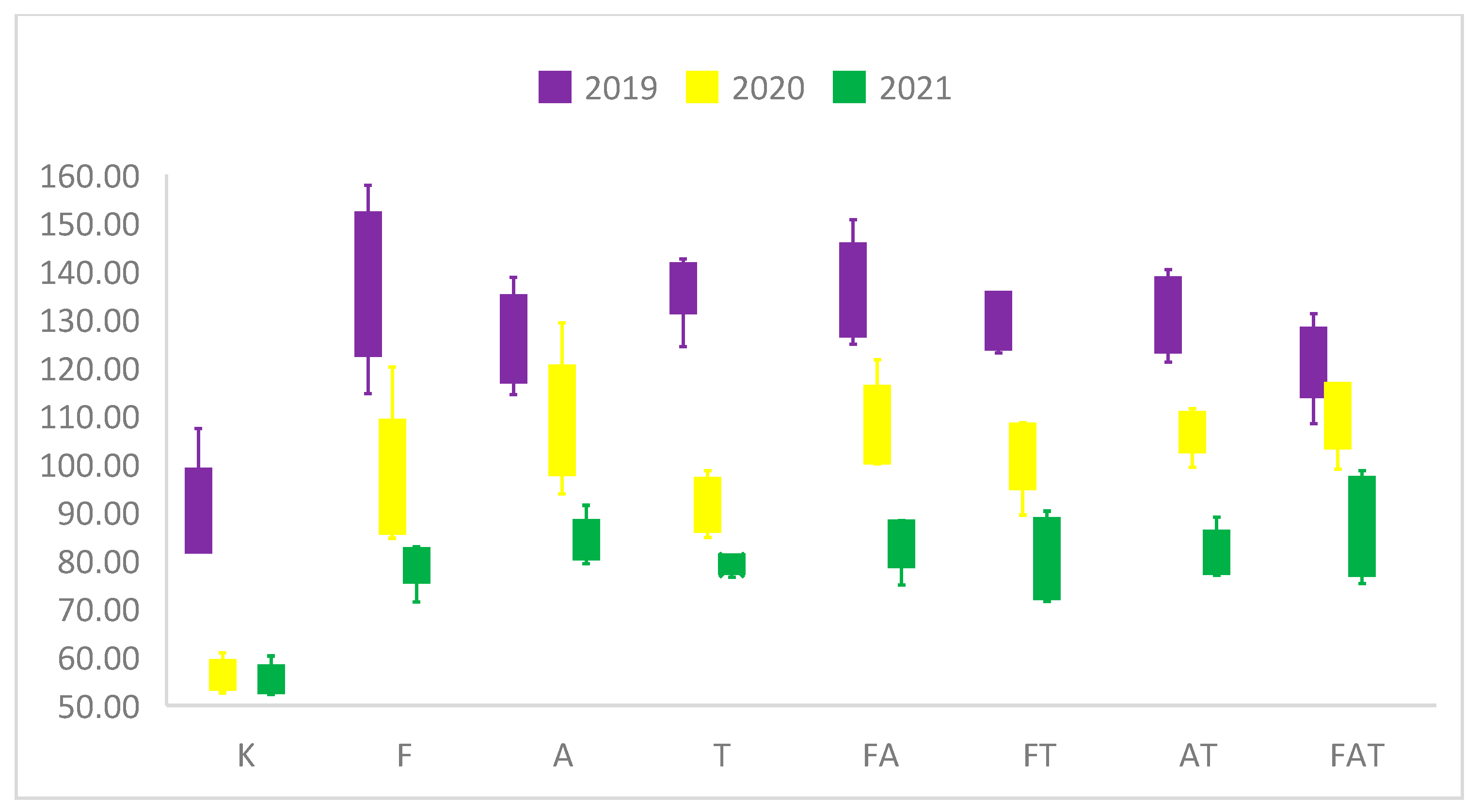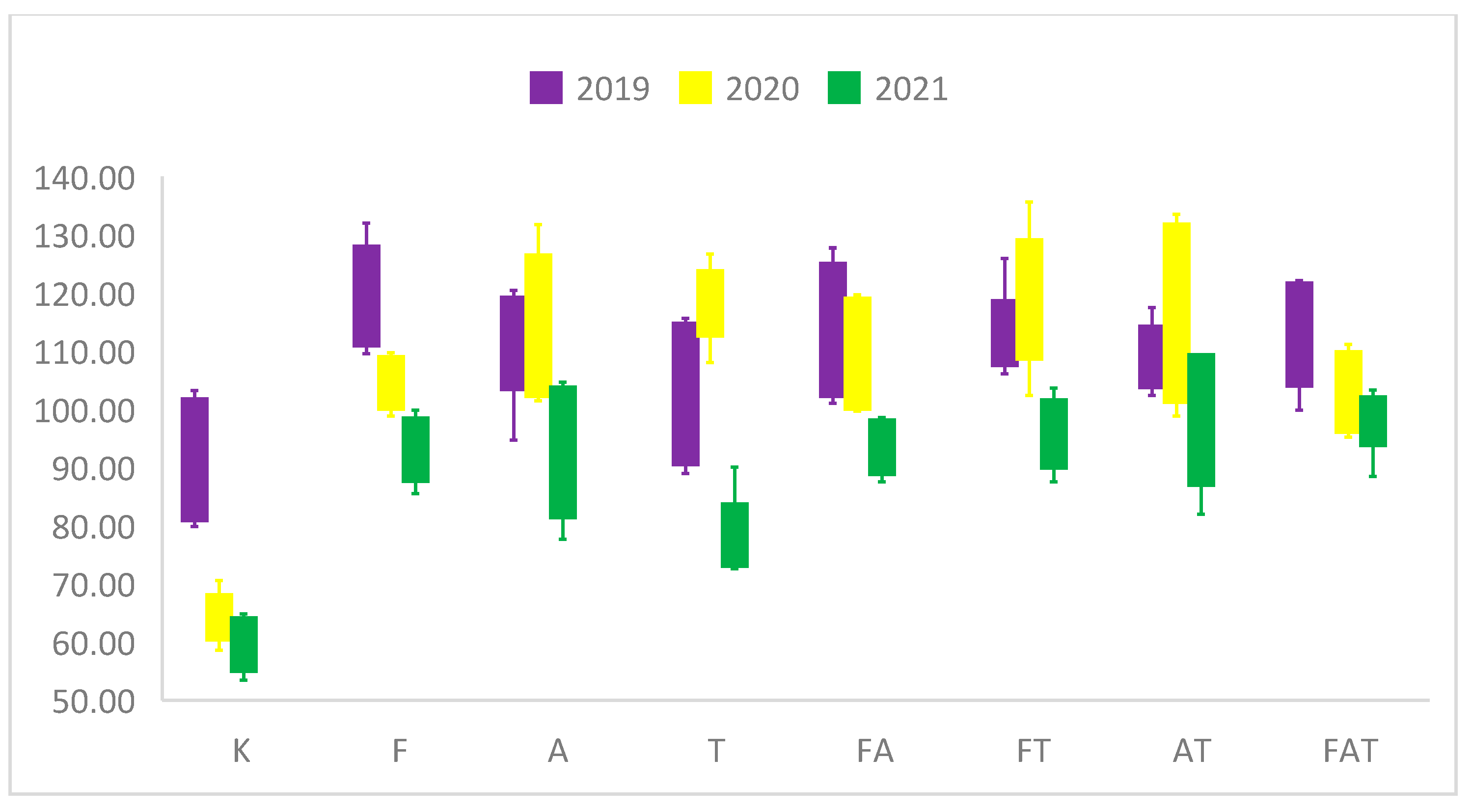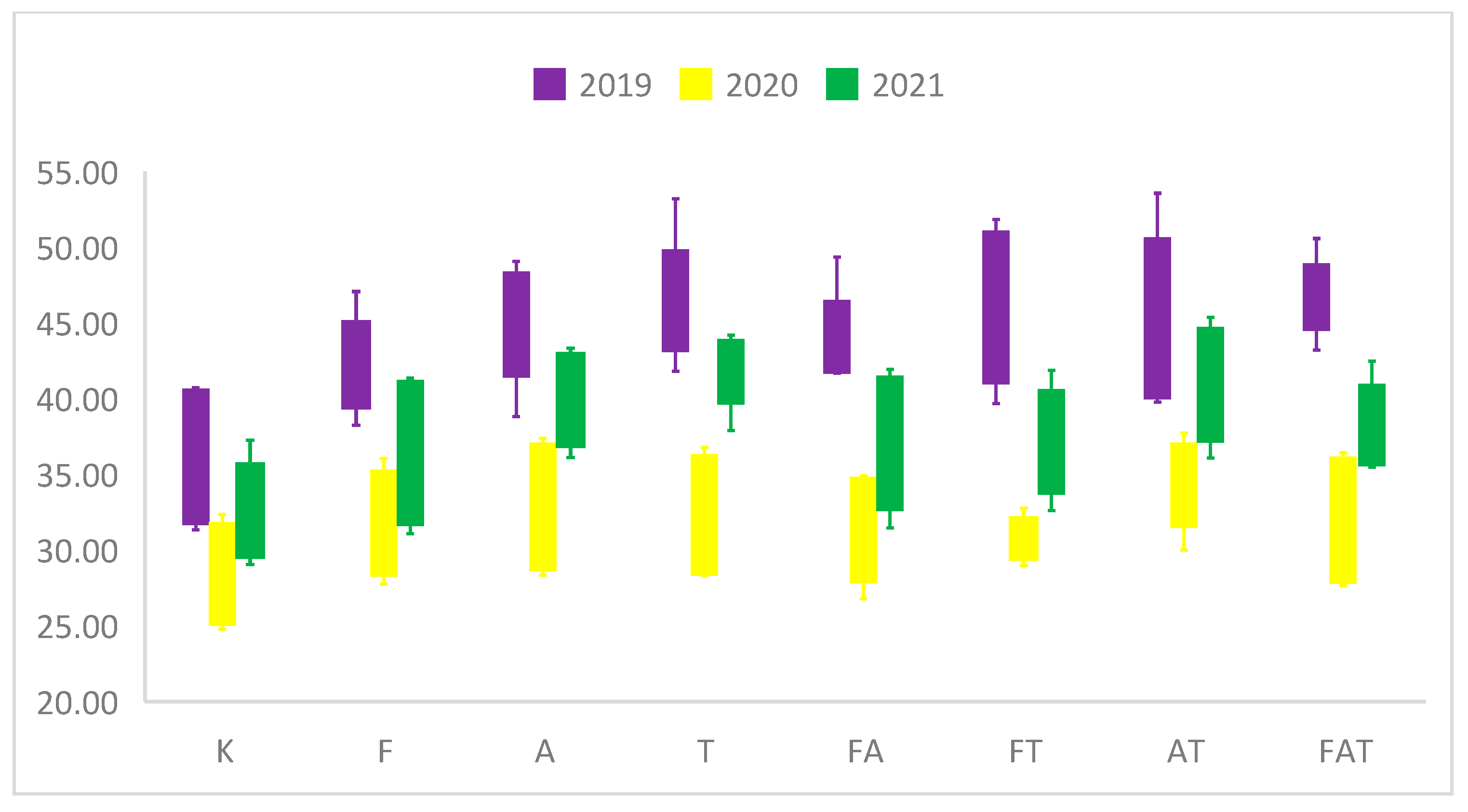1. Introduction
The growing global food demand, within the constraints of limited agricultural land, requires a shift towards sustainable agricultural practices that optimize both yield and crop quality. Intensive cultivation practices, while increasing yields, poses substantial environmental risks, including soil degradation, erosion, and pollution stemming from the application of synthetic inputs such as pesticides and fertilizers [
1]. These traditional intensive agricultural practices, though often effective in the short term, can be economically costly and exert long-term detrimental effects on soil health, biodiversity, and the quality of agricultural products [
2]. Moreover, the success of agricultural production to meet market demands for high-quality products, particularly during periods of peak pricing, necessitates optimizing cultivation strategies.
Developing climate-resilient crops and enhancing agricultural efficiency are crucial for ensuring future food supplies, especially in the face of intensifying environmental stressors that will disrupt multiple crop growth stages. These intensifying stressors, particularly during seed fill, can simultaneously diminish both crop yield and nutritional quality, exacerbating existing vulnerabilities in the food system [
3]. Therefore, strategies to stabilize crop yields and maintain or enhance nutritional value under changing climatic conditions are essential.
Protected agriculture creates optimized, controlled environments (with features like heating, lighting, and cooling) to increase crop yields beyond those achievable with traditional open-field farming. This controlled environment protects crops from harsh weather, pests, and diseases. Within protected agriculture, soil and plant coverings further enhance yields and enable earlier planting and harvests by providing additional protection against temperature fluctuations, especially low temperatures and light frosts [
4]. Research indicates that these coverings modify temperatures and mitigate various abiotic stresses, which, in addition to promoting faster and higher yields, also prolong the growing season in colder regions [
5]. Low tunnels, particularly semicircular designs, and direct plant covers are increasingly used to protect crops, facilitating earlier planting and harvests, especially for warm-season vegetables like potatoes [
6]. While low tunnels create a small greenhouse effect, direct covers offer a cost-effective and easily implemented solution, often mechanized, for early open-field vegetable production. Both methods create a unique microclimate, allowing air, water, and sunlight penetration while shielding crops from adverse weather and pests, contributing to the growing demand for pesticide-free produce. They typically increase air and soil temperatures by an average of 1.5 °C [
7,
8]. Moreover, agrotextiles, durable and high-performance technical textiles, are known to boost productivity and crop quality due to the protection they provide from adverse weather [
9,
10]. Beyond crop covers, agrotextiles have diverse agricultural applications, including seed blankets, greenhouse shading, root-controlling pots, and lawn covers, as well as providing protection, shade, and weed and insect control for livestock [
11,
12].
Mulching techniques, as one more promising form of continuous soil cover, within sustainable agriculture offer a systemic approach to agricultural management. These practices mitigate soil erosion, enhance soil carbon sequestration, provide economic benefits, reduce groundwater pollution from agricultural runoff (including nitrogen-based fertilizer residues), and promote biodiversity and native biological carbon capture [
13]. A variety of substances can serve as mulching materials, including plastic, agricultural waste, animal excrement, sand, and gravel. Kader et al. [
14] categorize these materials as organic, inorganic, and specialized. Inorganic mulching materials encompass synthetic and polyethylene-based plastics. Organic mulches can be derived from sources such as animal waste, wood fragments, food processing byproducts, and agricultural residues. Furthermore, Adhikari et al. [
15] developed eco-friendly, readily applicable options like surface coatings, biodegradable polymer films, and compostable/photodegradable plastic films, which hold considerable importance in agricultural applications. Different mulching techniques are thought to be particularly beneficial in stressed environments (e.g., heat, drought, and salinity) by altering evaporation and transpiration rates, maintaining moisture levels around plant roots thus increasing the time available for plants to utilize water [
16]. Mulching helps retain nutrients within the root zone, promoting efficient uptake and minimizing nutrient loss through leaching. Mulch effectively suppresses weeds by acting as a physical barrier, limiting light transmission and hindering germination and seedling emergence [
17,
18].
The cultivation of staple crops worldwide, including the potato (
Solanum tuberosum L.), the world’s fourth most important food crop, plays a crucial role in global food security and livelihoods. Cultivated globally on nearly 18 million hectares, from smallholder farms to large-scale operations, potatoes represent a vital crop due to their adaptability and economic importance [
19]. While originating in South America, potato cultivation is now widespread globally. Global potato production reaches 376 million tonnes annually, with China leading the way at 94 million tons [
20]. Notably, China and India together contribute approximately one-third of global potato production, followed by Europe and the Americas. Potatoes are considered a vital crop due to their nutritional value, adaptability to climate change, and role in income generation. They offer a plant-based protein alternative, possess significant genetic diversity thanks to smallholder farmers, and exhibit greater resilience to harsh weather than many staple crops. Furthermore, potato cultivation has a smaller environmental footprint regarding water usage and carbon emissions. Potatoes are vulnerable to climate change, with extreme weather events impacting yields [
20]. While management practices influence yields (67%), the increasing frequency and intensity of climate-related stresses underscore the critical need for sustainable agricultural practices in potato cultivation. Mulching, as discussed above, offers a key strategy for mitigating these climate change impacts. By regulating soil temperature and moisture, mulching can help buffer potato crops against heat stress and drought, thereby stabilizing yields and ensuring more consistent production even under challenging environmental conditions. Furthermore, the benefits of mulching extend beyond climate resilience. As a component of conservation agriculture, mulching contributes to the maintenance of soil health, which is essential for the long-term sustainability of potato production systems and the preservation of this vital food resource.
Mulching foil accelerates early potato growth by elevating soil temperature, fostering rapid germination, root development, and stem emergence, leading to a harvest up to 10 days earlier. As Žnidarčič and Karić (2023) [
10] proved, the use of polypropylene covers in sweet potatoes specifically results in increased vegetative growth and tuber yield compared to traditional cultivation methods. The foil’s moisture retention and weed suppression further support robust plant growth by optimizing nutrient availability and reducing competition. However, this increased warmth also heightens frost sensitivity, necessitating the use of agrotextile for protection. Careful management is crucial to ensure all stems emerge through the foil to prevent damage. The plant responds with accelerated canopy development and earlier tuber initiation due to the favorable microclimate created by the foil, influencing its overall growth trajectory and harvest timing [
21,
22].
In this paper, we set up the hypothesis that different plant covering methods, plastic mulch, agrotextile, low tunnels, and their combinations, will significantly enhance early potato production. We have examined how the application of these methods will improve the number of stems per plant, number of tubers per stem, number of tubers per plant, average tuber mass, tuber mass per plant, and overall yield in both Cleopatra and Riviera potato varieties, over three consecutive production years.
2. Materials and Methods
2.1. Location and Site Description
The impact of different covering types on the yield and yield components of early potatoes was examined over three consecutive years, from 2019 to 2021. The experiment was set up in Begeč (45°14′35″ N; 19°36′31″ E), located in South Bačka, in the Autonomous Province of Vojvodina, Serbia.
2.2. Experimental Design and Treatments
The effect of different types of soil and plant coverings on yield and yield components was studied in two potato varieties—Cleopatra and Riviera.
Cleopatra is a high-yielding, early maturing potato variety originating from the Netherlands, characterized by its distinctive red-skinned, oval to round-oval tubers with pale yellow flesh. It exhibits good dry matter content, making it suitable for table and seed potato production. While demonstrating moderate to high resistance to Wart Disease and moderate resistance to several other common potato diseases, it has low resistance to certain potato cyst nematodes. Cleopatra is valued for its reliable yields and early harvest, contributing to its popularity among growers seeking early-market potatoes.
Riviera is an extra-early potato variety, also, originating from the Netherlands, known for its rapid maturation and high yields of uniform, oval to long-oval tubers. These tubers feature smooth, light yellow skin and light yellow flesh, with shallow eyes. Primarily cultivated for the early fresh market, Riviera demonstrates good resistance to common scab and Potato Virus A, and moderate resistance to Potato Virus Y. This variety’s key characteristics include its low dry matter content, which influences its suitability for various culinary applications [
23].
The field trial was conducted over a period of three years using a split-plot design. The main plot factor was cultivar, while treatments were assigned to subplots, replicated within each year. The structure of the design included replications nested within treatment and year, which was accounted for through the inclusion of appropriate random effects in the models. For factor B, the experiment included the following production methods (variants): control variant—conventional planting (O)—b1; mulching (F)—b2; agrotextile (A)—b3; low tunnel (T)—b4; mulching + agrotextile (FA)—b5; mulching + low tunnel (FT)—b6; agrotextile + low tunnel (AT)—b7; mulching + agrotextile + low tunnel (FAT)—b8 (
Figure 1).
All treatments (mulching, direct covering the plants with agrotextile, and setting up low tunnels), were carried out immediately after planting the tubers. Polyethylene low tunnels (1.5 m wide and 0.05 mm thick) and agrotextile (“Agryl” mass 17 g/m2) were set up manually while mulching with polyethylene film (0.012 mm thick and 120 cm wide, black) was carried out mechanically. The low tunnels were applied 24 h a day until the risk of low temperatures had passed, specifically until the temperature reached 20 °C.
The difference in air and soil temperature at a depth of 10 cm between covered and uncovered soil was also monitored. It was found that the average daily temperature above the covered soil differed, on average, by 3.87 to 5.62 °C. At the soil surface, under the agrotextile, the temperature was 1.87 to 2.36 °C higher, while under low tunnels, the temperature was recorded as 3.58 to 4.01 °C higher. In the combination of mulching and low tunnels, the temperature was higher by 5.03 to 6.3 °C compared to the surface of the uncovered soil, while in the combination of mulching and agrotextile, the temperature difference ranged from 2.3 °C in the morning hours to as much as 9.33 °C during the hottest part of the day. The soil temperature at a depth of 10 cm in the variant where only mulching was applied was, on average, higher by 3.32 to 5.16 °C compared to the uncovered soil. Under the agrotextile, the temperature was higher by 3.78 to 4.75 °C, while under the low tunnels, the soil at a depth of 10 cm was 1.98 to 2.15 °C warmer. In the combination of low tunnels and mulch film, the increase in soil temperature at a depth of 10 cm ranged, on average, from 4.25 to 5.12 °C. In the combination of agrotextile and mulch film, the increase in temperature ranged from 2.90 to 3.29 °C, and in the combination of agrotextile and low tunnels, the soil temperature at a depth of 10 cm was 2.15 to 2.97 °C higher. In the combination of all types of coverings, both for the soil and the plants, an increase in temperature of 1.2 to 1.98 °C was recorded.
2.3. Applied Agricultural Technology
Standard agrotechnical practices for early potato cultivation were followed throughout the three-year experiment, with all agricultural operations performed promptly and within optimal timeframes. Carrots served as the pre-crop each year. Class A seed tubers (35–55 mm) were selected and sprouted according to the standard methodology described by Broćić and Barčik [
24]. Mechanical planting was carried out on 17 March (Year 1), 23 March (Year 2), and 21 March (Year 3). Tubers were planted individually per hill, with a row spacing of 65 cm and an intra-row spacing of 30 cm (10 plants per subplot). Based on annual soil chemical analyses, fertilization consisted of 300 kg/ha of NPK 5-14-28 was applied during basic soil preparation, as well as a pre-planting application of 150 kg/ha of ammonium-nitrate (AN). The following early potato morphological characteristics were assessed: number of stems per plant, number of tubers per stem, number of tubers per plant, average tuber mass, tuber mass per plant, and yield. Measurements were taken from five plants per treatment within each replication. Yield was determined from 10 m² plots and extrapolated to tonnes per hectare.
2.4. Statistical Analysis
The analyzed traits were classified into two groups: count variables (number of stems per plant, number of tubers per plant, and number of tubers per stem) and continuous variables (tuber mass per plant, one tuber mass, and tuber yield per ha). All models were formulated in accordance with the experimental design and tailored to the distributional properties of particular response variables.
For the count variables, three alternative models were fitted: a Poisson model, a negative binomial model, and a COM (Conway–Maxwell Poisson)–Poisson model. Each model included treatment, cultivar, and year as fixed effects, along with all their interactions. A nested random effect structure reflecting the design (replication nested within treatment and year) was used. To assess the adequacy of each model, diagnostic checks for overdispersion were performed using simulation-based residual analysis. Model comparison was based on the Akaike Information Criterion (AIC), with lower values indicating better model fit. The presence of overdispersion was specifically evaluated to justify the selection of the most appropriate model among those tested.
For the continuous traits, linear mixed models were fitted. The fixed effects structure was the same as for the count models, including all interactions between treatment, cultivar, and year. Random effects accounted for the replication structure nested within the treatment and year. Model outputs included estimates of variance components, and the significance of random effects was assessed through likelihood ratio tests. Post hoc comparisons among treatment × cultivar combinations were conducted using estimated marginal means, with multiple comparisons adjusted to control for type I error.
All mentioned statistical models and their corresponding inferences were performed within the R computing environment (R Core Team, 2024) [
25].
3. Results
For the count variables (number of stems per plant, number of tubers per plant, and number of tubers per stem) Conway–Maxwell Poisson– model was selected. It revealed that the applied varieties had a statistically significant influence on the expression of the examined trait number of stems per plant, as well as all combinations of interactions (the interaction between treatments and varieties, the interaction between treatments and year, and the interaction between treatments, year, and varieties) (
Table 1). All types of interactions also had a significant influence on the expression of the second studied trait (the interaction between treatments and varieties, the interaction between treatments and year, and the interaction between treatments, year, and varieties at 0.001 level), as well as the applied treatments (
p < 0.001). The number of tubers per stem, as well as the number of stems per plant, was significantly influenced by the studied variety, as well as interactions (the interaction between treatments and variety, the interaction between treatment and year, and the interaction between treatment, variety, and year).
For the other three studied traits (tuber mass per plant, one tuber mass, and tuber yield per ha), the analysis of variance was performed using the Poisson model, and for all three traits, the significance of all effects was established, except for the interaction of treatment and year for the traits tuber weight per plant and tuber yield per hectare (
Table 2).
3.1. Number of Stems per Plant
Results shown in
Table 3 present the effect of the examined treatments (varieties and covering methods) on the number of stems per plant in different years of the experiment. In all three years, a significant difference was found between the applied varieties, with a significantly higher number of stems per plant recorded for the Riviera variety in 2019 (3.14), and for the Cleopatra variety in the consequent studied years (3.70 and 3.83). In the first year of the study, the highest number of stems per plant was recorded for treatment FA; however, it did not differ significantly from the control, nor from the other treatments of applied covering methods. In the other two years in which the effect of different methods of covering the soil and plants was studied, the highest value for the number of stems per plant was obtained for treatment A, but even in these two years, no statistically significant difference was observed between the applied treatments.
Table 4 presents the effects of covering techniques on the number of stems per plant in the studied cultivars (Cleopatra and Riviera) per year. The number of stems per plant did not differ significantly among treatments for the variety Cleopatra in 2019 or for Riviera in 2021. In 2020, Cleopatra plants grown with agrotextile had fewer stems compared to control plants, and also when compared to all other treatments (
Figure 2). Other treatments did not significantly affect stem number compared to the control. Conversely, in Riviera, the use of agrotextile increased significantly stem number compared to the control in 2020. In 2021, there were no significant differences in stem number among treatments for Riviera (
Figure 3). For Cleopatra, mulching alone and the combination of mulching and a low tunnel significantly increased stem number compared to the mulching and agrotextile combination.
3.2. Number of Tubers per Plant
During all three years of the study, the Riviera variety exhibited a statistically significantly higher number of tubers per plant compared to the Cleopatra variety (
Table 5). In the first year, the FAT treatment produced the highest number of tubers, although this was statistically significantly higher only than treatment A. However, in the second and third years, the control treatment produced the highest number of tubers, showing statistically significant increases compared to all other treatments in 2020, and compared to treatments FA and FAT in 2021.
The Cleopatra variety showed the highest number of tubers per plant in the control treatment in all three years of the study (8.45, 9.62, and 9.22, respectively). Statistical significance was established only in relation to treatments F and T in the first two years, as well as between the control and all other treatments in 2020, while in the third year of the study, the difference between the number of tubers in the applied treatments did not show significance in relation to the number of tubers per plant obtained in the control treatment (
Table 6,
Figure 4). In the Riviera variety, the highest number of tubers per plant was also obtained in the control treatment in 2020 and 2021 (
Table 6,
Figure 5). In 2021, this value was statistically significantly higher in relation to treatment F, FA, FT, and FAT. Statistical significance was also established between treatments T and FAT, as well as between FT and T. In 2020, no significant difference was established between the control treatment and the other studied treatments, nor between all the other studied treatments. In the first year of the study, the highest value for the number of tubers per plant was achieved in treatment AT, but statistical significance was established only in relation to treatment F.
3.3. Number of Tubers per Stem
The Riviera variety showed a significantly higher mean number of tubers per stem than the Cleopatra variety across all three years of the study (
Table 7). Specifically, in the first year, the control treatment yielded the highest number of tubers per stem (3.02), which was statistically significantly greater than the number of tubers per stem obtained with F and FA combination treatments. The control treatment also exhibited the highest mean number of tubers per stem in the second year, and this value was statistically significantly different from all covering treatments. In the third year, while the control treatment again showed the highest mean number of tubers per plant, this difference was not statistically significant compared to the other treatments.
In 2019, the Cleopatra variety showed the highest mean number of tubers per stem in the control treatment, although no statistical significance was found between the control and other treatments, nor among the other covering treatments. In the same year, the Riviera variety also had the highest number of tubers per stem in the control treatment, but this was statistically significantly different from treatments F, A, and FA (
Table 8,
Figure 6 and
Figure 7).
The second year of the study revealed that the AT treatment resulted in the lowest mean number of tubers per stem, being statistically significantly lower than treatments F, A, and FA, as well as the control treatment. Statistical significance was also observed between treatment FAT and treatments A and the control, and between treatments FA and FT and the control. Treatment A, which had the highest mean number of tubers per stem, differed statistically significantly from all other studied treatments, except for the control and the mulch film treatment. In the same year, the Riviera variety showed the highest mean number of tubers per stem in the control treatment, which was statistically significantly higher than all other treatments except FA. The mean number of tubers per stem for treatment FA also differed significantly from treatments A, T, and FT. Treatment A had the lowest mean number of tubers per stem, and this was statistically significantly lower than all other treatment treatments.
In the third year, the Riviera variety again had the highest mean number of tubers per stem in the control treatment, but this was not statistically significantly different from the other treatments. No statistically significant differences were found among the other treatments either. For the Cleopatra variety, the highest mean number of tubers per stem was recorded for treatment FA, but this did not differ statistically significantly from the other treatment treatments, and no significant differences in mean values were found among the other treatments.
3.4. Tuber Mass per Plant
Consistent with the previous trait, the Riviera variety exhibited a statistically significantly higher tuber mass per plant compared to the Cleopatra variety (
Table 9) Regarding the applied treatments, the combination of mulch film, agrotextile, and low tunnels resulted in the highest tuber mass per plant in the first two years of the study. Specifically, this value was significantly greater than the control treatment and the treatment with mulch film only in the first year, and significantly greater than the control treatment in the second year. In the third year, the simultaneous application of agrotextile and low tunnels produced the highest mean tuber mass per plant, which was significantly different from the control treatment. No significant differences were found among the remaining treatments.
For the Cleopatra variety, the lowest tuber mass per plant was consistently observed in the control treatment. Specifically, this was statistically significantly lower than all other treatments in 2019 and 2021, with the exception of treatment F in 2019. Additionally, in the first year of the study, a statistically significant difference was found between treatments F and AT. In 2020, the control treatment differed significantly only from the FAT treatment (
Table 10,
Figure 8). The other studied variety also exhibited the lowest mean tuber mass per plant in the control treatment across all three years (
Figure 9). This was statistically significantly lower than all other mean values, except for treatments F and FT in the second year. Furthermore, in the first year, a significant difference was observed between the FAT treatment, on the one hand, and treatments F and A, on the other.
3.5. One Tuber Mass
The average weight of a one-tuber mass differed significantly between the studied varieties (
Table 11). In the first year of the experiment, the Cleopatra variety exhibited a higher value, whereas the Riviera variety showed a higher value in the subsequent two years.
Compared to the control, all applied treatments in 2019 had a statistically significant positive effect on one tuber mass. A similar trend was observed in the second year, where the control showed the lowest average one tuber mass, being statistically significantly lower than the average values for the different covering treatments. This pattern persisted in the third year of the study.
Table 12 presents the average values of the one tuber mass for both studied cultivars over 3 years of study. Consistent with previous results, the one tuber mass also had the lowest average value in the control variant, for both studied cultivars in all three years of testing (
Figure 10 and
Figure 11). A statistically significant difference between the average values was not established only for the Riviera variety when applying low tunnels in the first year of the study. For the Cleopatra variety, statistically significant differences were also found between treatments F and FAT in 2019, and between treatments T and FAT in 2020. For the other studied cultivar, treatments FT, AT, and FAT differed significantly from treatment T.
3.6. Tuber Yield per Ha
The Cleopatra variety achieved a higher average tuber yield per hectare only in the first year of the study (
Table 13). However, in 2020 and 2021, a higher yield was observed in the other studied variety, Riviera. The difference in mean values between the two studied varieties showed statistical significance in all three years of the experiment. In the first year of the study, the highest yield was established with the simultaneous application of mulch film, agrotextile, and low tunnels, and it was statistically significantly higher compared to the yield achieved in the control and the treatment where only mulch film was applied. The control also achieved a significantly lower yield compared to the other treatments, except for treatment F. In the second year of the study, the yield ranged from 27.1 to 33.4, but no significant difference was established between the mean values achieved with the application of different treatments. In 2021, the highest yield was achieved with treatment AT, and it was statistically significantly higher only compared to the control.
The combination of all three covering types (mulch, agrotextile, and low tunnels) influenced the creation of the highest tuber yield per hectare, in 2019, for the Cleopatra variety (
Table 14,
Figure 12). In the same treatment, the tuber weight per hectare differed significantly from the control and the variant where only mulch film was applied. Within the remaining treatments, variant A showed statistically significant differences from both the control variant and variant F. In the other studied variety, and in the same year of the study, the highest mean value of the studied trait was also obtained with the application of all three types of soil and plant covering (46.6 t/ha), and it differed statistically significantly only from the control (
Figure 13). The mean value measured in the control was statistically significantly lower compared to the other applied treatments, except for the treatment where only mulch film was applied. In the second year of the study, the mean values for the Riviera variety ranged from 28.5 t/ha (in the control variant) to 34.5 t/ha (variant AT), but no statistical significance was established between any of the applied treatments. For the Cleopatra variety, variant AT also produced the highest mean yield per hectare, showing a statistically significant increase compared to the control. No significant differences were observed among the remaining treatments.
In the third year of the study (2021), the highest yield for the Cleopatra variety was obtained with the simultaneous application of agrotextile and low tunnels (40.7 t/ha), and this was statistically significantly different from the control and treatment F. Among the other treatments, a significant difference was found between the control variant and variant A. In the other variety studied, the highest yield was achieved with the application of low tunnels (41.8 t/ha). This treatment (T) showed statistically significant differences compared to the control. Significant differences were also found between the control and treatment A.
4. Discussion
Soil and plant covering are important agrotechnical practices that ensure the extension of the growing season in colder climates. Research indicates that these methods help regulate temperature, leading to faster growth and higher yields of better quality in diverse crops [
9,
10,
26,
27,
28,
29,
30,
31,
32]. Additionally, various covering techniques contribute to soil conservation, efficient water and nutrient management, and pest protection [
33].
Early potato production is tackled with the genetic potential of its cultivars, applied agrotechnical practices, and agroecological conditions. These factors influence the yield and quality of early potatoes, which was confirmed by the results of our research. In addition to the significant individual influence of cultivars, applied covering techniques, and different years of cultivation, almost all interaction effects showed significance at the 0.001 level (except for the interaction of applied treatment and year).
In three research years, all applied plant and soil cover treatments contributed to a higher yield compared to the control. Still, significance was not established for all differences in mean values. In the first year of research, when applying almost all covering treatments and their combinations (except mulch film), significant differences were established in the achieved yield. In the second year of the experiment, although higher yields were achieved when the cover treatment was applied, the difference in mean values did not show significance. In contrast, in 2021 a significant difference was found between the control variant and the application of agrotextiles, low tunnels, and a combination of agrotextiles and low tunnels. These results confirm the results of the analysis of variance, which indicate the importance of growing conditions in different years of research (26%), as well as the interaction of applied treatments, cultivars, and year (32%).
A study conducted in Iraq examined how different plant covering treatments affect the yield of two potato cultivars. The results showed that covering potatoes accelerated emergence (by up to 37%) and increased plant height (by up to 33%) compared to the uncovered control group. Additionally, covering increased the total yield per hectare by 31% compared to the same variety grown without any covering [
34]. This highlights the importance of selecting the right cultivar in combination with effective covering methods to maximize yield.
In Poland, covering crops with nonwoven polypropylene resulted in an average increase of 4.63 t/ha (33%) in marketable tuber yield. Furthermore, a similar study reported that marketable tuber yield increased by up to 9.84 t/ha (52%) [
35].
Studies comparing agrotextile and perforated plastic film as covers indicate that covering plants leads to higher yields than the uncovered control treatment. The increase in yield was 5.15 t/ha, with agrotextile-covered plots achieving an additional 6.41 t/ha. In comparison, those covered with plastic film gained 4.27 t/ha [
36].
The impact of different covering methods on potato stem production is significant and depends on the materials and techniques used. Research shows that various covering methods can improve growth parameters, including the number of stems per plant [
37,
38]. Some studies suggest that the benefits of these methods may not be uniform across all potato cultivars or agroecological conditions, indicating the need for tailored approaches in different agricultural practices [
39].
In our research, we did not establish the significance of the applied treatments on the number of trees per plant. Yet the significance of the treatments was shown through the interaction with the applied variety, as well as the year of cultivation.
The number of stems per plant in 2019 ranged from 2.35 (A) to 3.57 (FA), in 2020 from 3.23 (FA) to 3.80 (A), and from 3.32 (FA) to 3.89 (T) in 2021. The lack of a significant impact of the applied treatments on stem number was likely due to relatively favorable temperatures in April during the period of intensive vegetative growth.
The average number of tubers in the three-year study ranged from 7.53, recorded in the mulching variant, to 9.43 tubers in the control variant. However, although the control had the highest tuber count, 11% of those tubers were smaller than 28 mm and classified as non-marketable.
Research suggests that mulching not only affects total yield but also improves tuber quality by increasing their size and mass. This is attributed to improved soil conditions, such as better water retention and temperature regulation, which are critical for tuber development [
40,
41,
42].
Although plant covering techniques are effective methods for increasing potato yield [
43,
44,
45], it is essential to consider specific agroecological conditions and practices to optimize their benefits. Some studies suggest that without proper management, the advantages of these methods may not be fully realized, highlighting the need for tailored agricultural practices.
Mulching significantly enhances potato tuber mass through several interconnected mechanisms. Improved water use efficiency, by up to 40% in some studies [
46], allows plants to utilize water more effectively, crucial for optimal tuber development. Mulching also plays a vital role in regulating soil temperature, creating a more favorable environment for tuber growth, and minimizing plant stress. Studies have shown that optimal tuber yields correspond to a vegetative above-ground mass temperature of 25 ± 2.5 °C under adequate irrigation. Furthermore, mulching promotes the production of larger tubers (≥50 mm), increasing both overall yield and the proportion of marketable tubers. Finally, effective weed suppression by mulching minimizes competition for resources, further contributing to increased tuber mass [
47].
In our experiment, all covering techniques and their combination positively influenced tuber mass per plant. Almost all treatments (except F in 2019 and 2020 and FA and FT in 2020) across all three years of study resulted in a significant increase in tuber mass compared to the control variant. The highest tuber mass per plant was observed in the variants with double plant covering, with (FAT in 2019 and 2020) or without mulching (AT—2021), while the lowest mass (excluding control) was recorded in the F (2019. and 2020) and F and FA (2021) variant. The study by Chandra et al. [
46] specifically highlighted that both mulching and irrigation treatments led to a higher production of large-sized tubers (≥50 mm) compared to treatments without covering. This finding suggests that mulching not only increases total yield but also positively influences the size of individual tubers, thereby increasing their mass. The covering technique and mulching significantly improved both the size and mass of potato tubers and contributed to a higher number of tubers per plant, which is crucial for overall yield [
48].
The study by Chang et al. [
41] demonstrated that polyethylene (PE) mulch increased potato yield by 17–29% and the number of larger tubers (>80 g) by 13–34%, with transparent PE mulches providing the best results. Mulching improved vegetative growth, contributing to greater photosynthetic efficiency and better plant growth and development. Our findings align with these previous studies.
The experimental results indicate that all effects have a significant influence on the mass of a single tuber. The greatest influence was observed for the T × C × Y interaction (59%). Cultivar Cleopatra had a highly significant greater one tuber mass in 2019, while the higher mean value of one tuber mass in the other two years of the experiment was found in cultivar Riviera. All covering techniques significantly increased one tuber mass in all three years of investigations.
Additionally, the results indicate that, over three years, the tested treatments significantly affected tuber size. The largest proportion of the total tuber count consisted of tubers sized 45–55 mm (large marketable tubers), accounting for approximately 40%, whereas in the control group; this proportion was 31%. The highest percentage of small marketable and non-marketable tubers was recorded in the control group (28%), while in the treated variants; this percentage ranged from 12% to 16%. According to the research by Orzolek and Lamont (2013) [
49], potatoes show greater benefits from mulching compared to other crops, with the use of plastic mulch leading to an average increase of 24% in the yield of marketable tubers compared to crops without mulch.
The implementation of covering techniques increased yield and facilitated earlier harvesting, which represents a significant advantage in early potato cultivation. This phenomenon can culminate in enhanced market value and economic benefit for producers, as potatoes harvested in the early season frequently command higher prices.
For both studied varieties, when considering both earliness and yield together, the most favorable treatment was the combination of plastic mulch and agrotextile. The only exception was the second year of the study for the Riviera variety, where the highest percentage of marketable tubers relative to total tuber mass was observed in the FAT treatment.
5. Conclusions
Based on the obtained research results, it can be concluded that mulching, direct plant covering with agrotextile, the use of low tunnels, and their combinations yield favorable results in achieving earlier maturation, higher and more stable yields, and better quality. The obtained results can serve as a basis for improving early potato production, increasing yield and quality, achieving earlier maturation, and determining the optimal and most profitable production method.
Future research should include an assessment of the economic viability of plant covering methods to determine their long-term sustainability under different production conditions. Although the applied agrotechnical measures significantly increased the yield and quality of early potatoes, it is also important to consider their impact on production costs and potential profit for growers.
Furthermore, given the growing concern about the presence of microplastics in soil, which can negatively affect soil fertility and product safety, the use of organic materials instead of plastic coverings is recommended. Organic materials can contribute to ecosystem preservation, pollution reduction, and the production of safe food, ensuring the sustainability of these methods in modern agriculture.
